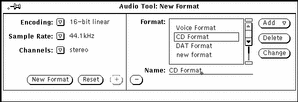New
Use the New menu to clear the current audio file or select a new audio data format. Press MENU on New and drag to the right to display a pop-up menu with format choices. (If you click SELECT on New, the display canvas is cleared and retains the current format.) The selected audio format stays in effect until the next New operation (or other operation that loads a new audio file, such as Open). When recording a new file, you have the option of saving in the current format or in a new format.
If there is an unsaved sound file in the display canvas, a confirmation message appears, saying that the file is modified and asking if you want to discard the edited data. Click SELECT on the Continue button to clear the display canvas and begin recording. The confirmation message can be disabled in the Edit Properties... window.
You cannot undo a New operation.
Audio Format Choices
Click SELECT on the format of your choice. You can retain the current format or choose one of the standard formats--Voice, CD, or DAT. (If an audio format is not supported by the audio hardware, the corresponding menu item is disabled.) User defined formats may also be included and you can choose New Format... to define a new format.
New Format...
Click SELECT on the New Format... choice in the New menu to select, create, or edit the characteristics of a recording format. The Audio Tool: New Format window, shown in Figure 11-13, is displayed.
Figure 11-13 Audio Tool: New Format Window

Encoding:
Open this menu with a MENU click to select a type of encoding. Then, click SELECT on your choice of 8-bit m-law, 8-bit A-law, or 16-bit linear. The 16-bit linear encoding provides better accuracy (signal-to-noise ratio) than the two 8-bit encodings. However, the 16-bit linear encoding requires twice the storage capacity. Stereo audio data must use 16-bit linear encoding to play on a machine with stereo capability.
Sample Rate:
Open this menu with a MENU click to select a sample rate. Higher sample rates provide better high-frequency response (at the cost of larger file sizes). Click SELECT on your choice.
Channels:
Open this menu with a MENU click and click SELECT on your choice of channels (mono or stereo).
New Format Button
Click SELECT on the New Format button to clear the current audio file and reset the data format to match the currently selected audio format.
Reset Button
Click SELECT on the Reset button to restore the panel so that it displays the current audio format.
+ Button
Click SELECT on the + button in the New Format window to display an extended window, shown in Figure 11-14. The Format scrolling list displays the formats available to you. Note that formats are stored on a per-user basis, so that the formats listed (other than the standard Voice, CD, and DAT) have been created under your user name.
Note -
Audio formats and preferences are stored in the $HOME/.audiorc file (where $HOME is the name of your home directory).
You can use the New Format window to name a format type to appear in the New and Save As... menus. You can also use this window to add, change, or delete an audio format.
Click SELECT the - button to close the extended part of the New Format window.
Figure 11-14 New Format Window Extensions

To create a new format:
-
Select the new format's encoding, sample rate, and number of channels from the lefthand part of the window.
-
Type the new format's name in the Name: field.
-
Click SELECT on the Add button.
The new format is added to the bottom of the list. To add the new format elsewhere, click MENU on Add and choose Before, After, Top, or Bottom. The new format will appear in the list of formats.
- © 2010, Oracle Corporation and/or its affiliates
